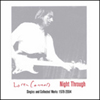 This mostly exhaustive triple-disc set spans four decades of Loren MazzaCane Connors' work, collecting 7" and 12" singles, compilation tracks, private CD-Rs, collaborations and unreleased pieces. For an artist with such a large and intimidating back catalog as Connors', Night Through serves as a perfect introduction, cutting straight through the uniqe avant-primitive guitarist's baffling discography, showcasing a variety of approaches, and by its very nature focusing on shorter, more approachable pieces.
This mostly exhaustive triple-disc set spans four decades of Loren MazzaCane Connors' work, collecting 7" and 12" singles, compilation tracks, private CD-Rs, collaborations and unreleased pieces. For an artist with such a large and intimidating back catalog as Connors', Night Through serves as a perfect introduction, cutting straight through the uniqe avant-primitive guitarist's baffling discography, showcasing a variety of approaches, and by its very nature focusing on shorter, more approachable pieces.
Family Vineyard
Perhaps because of his extreme prolificacy, his idiosyncratic and often intuitive approach to blues guitar, or his early reticence to reveal much about his musical project, Loren Connors is most often compared to Jandek by those trying to situate the artist in a generic context. Although the last few years have seen a couple of surprise collaborations between Connors and the mystery man from Corwood, the comparison of the two artists is a red herring, in my opinion. Jandek's music is bleak and tuneless, and whether by coincidence or design, is virtually unlistenable to all but the most courageous. Connors, though he has produced much work that could only be described as experimental or avant-garde, never seems to become completely untethered from a bedrock of melody, tunefulness and emotive, expressive phrasing. Even after all these years, Jandek and his guitar seem uncomfortably alienated from each other; where Connors and his guitar seem on the closest terms possible. Even when Connors painstakingly puils the most strained, atonal vibrato bottleneck drones out of his instrument, man and guitar seem as one, and the playing never reaches my ears sounding purposely befuddling, as does much of the modern improv scene.
Loren Connors' early work consists of successive mutations of a particular idiom of blues, specifically the bottleneck style of Robert Johnson and other Mississippi Delta blues musicians. Out this haunted, primitive twang, Connors gradually developed an idiosyncratic style that is totally unique without sounding the least bit affected. Though the style inevitably carries with it suggestions of the American primitive style as defined by Harry Smith's Anthology of American Folk Music, and also of the sound that has come to signify the haunted plains of the mythical American frontier, there is never a sense that this style is not organic to Connors himself. It is unselfconscious and hypnotic, a reservoir of fragile sound that carries with it a cultural memory that only strengthens its meditative power. Connors is capable at times of sounding like two or three guitarists playing at once, high trebly curling overtones matched by acoustic strumming underneath, sunburnt electric squalls kicking out sprays of swamp mud with each lick, and undercurrents of drone created by feedback and low-fidelity recording equipment.
Night Through does a fantastic job of charting Connors' trajectory, from the early bottlenecking of singles like "Come On In My Kitchen" and "Ribbon O'Blues," to the manic-depressive high-lonesome wail of "Saoirse (Freedom)," to the more abstractly progressive suites such as the nine-part "Stations of the Cross" that takes up a good bit of the first disc. It is with much interest that I note the fact that Connors' recordings, presumably by design, become more low-fidelity as the decades pass, with layers of tape fuzz and blunted amplifier distortion contributing the grainy atmosphere suggested by Connors' dusty, resonating electric guitar figures. As inspiration, Connors tackles blues standards or traditional registers; or alternately, creates improvised pieces inspired by historical events with personal resonance, such as the Irish famine or Biblical scenarios; bits from verse from Keats or art exhibitions by friends and associates serve as fodder for other tracks.
Appearing on disc two of this set is a 15-minute live performance by Haunted House (originally released in a CD-R limited to 30 copies), a group comprising Connors, Suzanne Langille, Andrew Burnes and Neel Murgai. Its amazing to witness how easily Connors made the transition from lone-wolf solo blues guitar to playing within the group context, and Haunted House consistently create the sort of hypnotic avant-rock that would win the admiration of Thurston Moore, Alan Licht, Keiji Haino and Jim O'Rourke, all of whom eventually collaborated with Connors. The performance included here is particularly electric, Connors leading the fray with some absolutely, frighteningly possessed lead guitars, whining, clawing and hammering his way across the cerebral cortex in a series of solos that are so senseless, they make all the sense in the world.
Ending with a strange and luminous two-part wah-wah pedal tribute to Miles Davis that sends out gaseous arcs of rippling, textural soundwaves, this triple-disc set attests to the genius of Connors' particular soundworld. It is well-known by now that Connors was diagnosed with Parkinson's Disease in the early 90s, but paradoxically this diagnosis seems to have resulted in a flurry of activity, and the past few years have seen a record number of solo and collaborative works issued on labels like Table of the Elements. But if anyone asked me where to start with Connors, I'd have to point them towards this set. It's a remarkably sequenced and packaged set that showcases the career of one of the avant-garde's most approachable outsiders.
samples:
Read More

